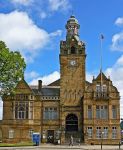Cleckheaton is a town in the Metropolitan borough of Kirklees, in West Yorkshire, England. Historically part of the West Riding of Yorkshire, it is situated south of Bradford, east of Brighouse, west of Batley and south-west of Leeds. It is at the centre of the Spen Valley and was the major town in the former borough of Spenborough. Cleckheaton has a history as a mill town and forms part of the Heavy Woollen District.
History
Early history
The Spen Valley was once heavily wooded. Evidence of human habitation in Mesolithic and Neolithic times has been found in the area. Roman remains have been found in the valley and it is thought that roads from York to Chester, and from settlements in Halifax and Wakefield, passed through Cleckheaton and the junction gave rise to a staging post.
Cleckheaton was in the ancient parish of Birstall. A chapel of ease, known as the White Chapel (later Whitechapel) was established.
Textile working
The area was very disorganised for a long time after the Norman Conquest and the richest townships at that time were still the richest 300 years later as the Poll Tax returns of 1379 show. They also demonstrate the lack of administration as only the richest four of the 227 families living in the Spen Valley were made to pay more than the 4d (approx. 2p) minimum tax. These tax returns also show the recent deviation from the traditional sources of wealth in the area (i.e. farming and allied trades). These were centred on textiles and included dyeing, weaving and fulling (common names in the area nowadays still recall these early trades: Lister- dyer, Webster- weaver, Walker- fuller). The spread of these trades was also a result of the absence of regulation of the area. Due to the lack of manorial control, land was divided between all the sons in a family rather than just passing to the eldest. As the farmland owned by a family got smaller they became unable to support the family and so people turned to production of woo
